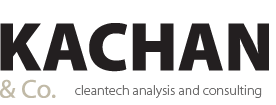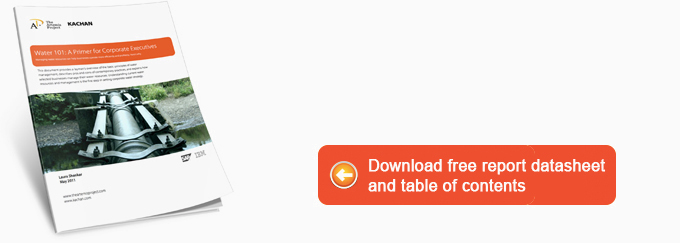A layman’s overview of the basic principles of water management. Describes pros and cons of contemporary water practices, and explains how selected businesses manage their water resources. A must-read for company executives charged with setting corporate water strategy.
Water 101: A Primer for Corporate Executives
Managing water resources can help businesses operate more efficiently and profitably. Here’s why.
A joint report by The Artemis Project and Kachan & Co., May 2011.
When it comes to resource management, water has taken a distant back seat to energy in most companies’ strategic planning. But efficient, sustainable water management practices will become an increasingly critical aspect of doing business for every company, from retail to consumer goods to heavy industry and beyond.
Population growth, climate change, and an aging infrastructure all are contributing to a future in which clean water will be harder to access. As our global thirst increases, the infrastructure that much of the developed world has relied on is beginning to age beyond its useful life. Beyond physical decay, we are also recognizing some problems with how we manage water resources. Pollution and contamination of our natural water resources are reaching crisis levels, as treated water is returned to ecosystems.
Centralized water management and treatment has had major benefits for human health in the past, but these systems are facing significant challenges in the years ahead. In this report, we review the primary ways in which wastewater is collected, filtered, disinfected and treated before being released back into natural water systems. The information provided helps demonstrate the diversity of contaminants and challenges that centralized treatment addresses.
With few exceptions, centralized water treatment facilities generate a single grade of water for every use, whether it will be used as tap water or to fill a toilet. This practice uses significant energy and materials and generates significant waste.
For business, addressing these issues can create substantial value. Through on-site wastewater management, more efficient practices, and in some cases creative re-invention of manufacturing processes, companies can slash water and wastewater management costs while creating a more stable operation.
This report equips the reader to better understand the benefits and challenges of today’s water management practices, provides an overview of current water treatment practices and suggests opportunities for businesses to create business value from these issues.
Methodology
This report was authored with data from national agencies, latest academic papers, leading industry organizations, corporate water managers and engineering associations. Leading vendors, utilities, investors and others also informed the report.
Companies receiving significant attention in report
The report references water savings by Starbucks (6 million gallons of water saved daily) and Wal-Mart (80-90 percent of water use reduced) and identifies selected vendors of water technologies.
DOWNLOAD FREE DATASHEET AND TABLE OF CONTENTS OF WATER 101: A PRIMER FOR CORPORATE EXECUTIVES
ENTER YOUR INFORMATION BELOW.
"Efficient, sustainable water management practices will become an increasingly critical aspect of doing business for every company, from retail to consumer goods to heavy industry."
-From the report



